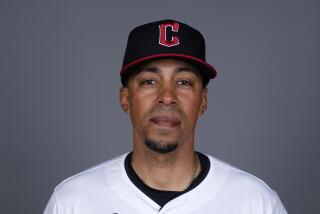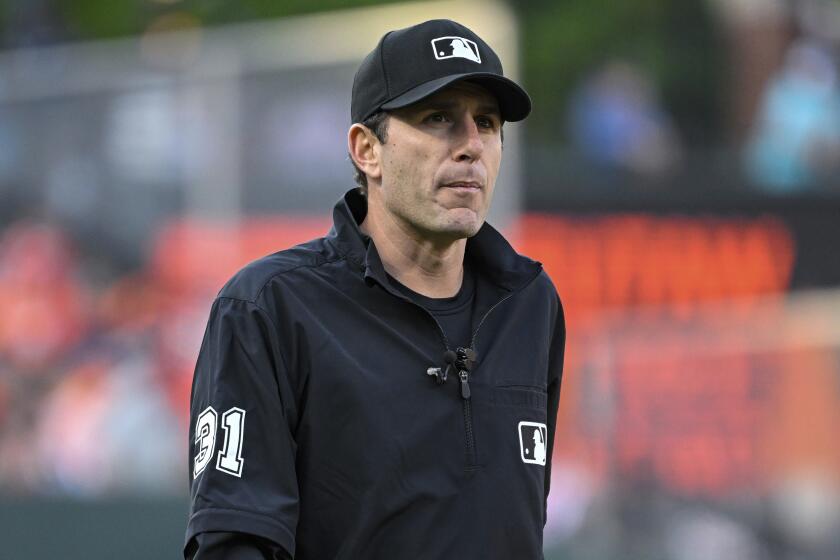Hagins Has Heart, and Then Some
- Share via
ALISO VIEJO — Stephan Hagins has known his share of despair--when his father died, when doctors told him a valve in his heart was 89% blocked, when they told him after surgery he should never play baseball again, when school lawyers blocked his admission at Arizona State--but he was experiencing a new kind of emptiness last month as he drove down the freeway toward his apartment in San Diego.
“I had spent the whole day in my agent’s office and we had called about 75% of the teams in major league baseball, starting back East because of the time difference,” said Hagins, who hit .305 with 10 home runs for San Diego State as a junior this season. “Everyone of them said something like, ‘We know all about the kid’s abilities, but we were told to stay away from him.’
“I was about as low as I’ve ever been.”
Hagins, however, discovered a most uplifting message on his machine when he got home, a call from an Angel scout telling him they were considering drafting him and would like to see his medical records. Hagins, and agent Dave Smith of Santa Ana, hadn’t made it all the way west to Anaheim on their telephone travels when they quit for the day.
“This is the difference between the old California Angels and the new Anaheim Angels, between the old-school of major league baseball and an organization like Disney,” Hagins said. “They care about people and they want to investigate something on their own instead of just going by what they’ve heard.”
Tim Mead, the Angels’ assistant general manager who has been with the team for 17 seasons, says the credit should go to director of scouting Bob Fontaine Jr., who is in his 12th season with the club.
“Bobby’s job is to find talent, and if there are circumstances that are perceived to be obstacles in the eyes of other people, which in this case there were, it’s his job to check them out,” Mead said. “The medical concerns were looked into and addressed. Remember, there were concerns about Jim Abbott, too, but Bobby drafted him in the first round.”
The Angels drafted Hagins in the 31st round. He expects to sign a contract soon and then leave immediately for Boise, Idaho, to play with the Hawks, a Class A team in the Northwest League.
“In a period of three days, I went from a guy who had no chance whatsoever of making his dreams come true, to a guy who’s convinced it’s only a matter of time before I make it to the big leagues,” Hagins said. “And who better than the Walt Disney Co. to make your dreams come true?”
Smith is almost as ecstatic as Hagins, if maybe a bit more cynical.
“I have a feeling Disney thinks this would make a great movie,” he says.
The story line is certainly compelling enough.
If Hagins’ father, Guerry, who suffered a fatal heart attack on June 1, 1993, had died a few weeks later, Hagins would have been a millionaire professional baseball player four years ago.
For a couple of weeks, anyway. Then, he says, he would have been dead.
Hagins was born with a faulty heart valve, a condition known as aortic stenosis, but it never caused any problems in his youth. He hit .507 as a senior at University High in 1993, was a Times Orange County first-team selection and projected to be the No. 1 or 2 picks in the first round of baseball’s June free-agent draft.
He was four days shy of being guaranteed a fat signing bonus when his father died at age 60. Hagins was then examined by UCLA cardiologist Joseph Perloff, who discovered the severe blockage in the valve. Perloff performed an aortic valvuplasty--where a balloon is inserted--and the valve was restored to about 75% efficiency.
“He told me I wouldn’t have lasted two weeks in the heat and stress of playing in the minors before I had a heart attack,” Hagins said.
The Cleveland Indians eventually drafted Hagins in the 23rd round in 1993, but he opted for keeping a promise to his father to get a college education and enrolled at Arizona State.
He was prohibited from playing at Arizona State, however, because he couldn’t get medical clearance from “doctors who care only about covering [themselves] from malpractice suits.” He went through a lengthy legal battle and eventually found a spot at San Diego State.
But even that didn’t turn out to be the position he had hoped for.
Hagins, who was rated ahead of Seattle’s Alex Rodriguez by the Major League Scouting Bureau in 1993, achieved that status with his bat. But he also was a promising young catcher who believed his future in the game was behind the plate.
He had gone almost an entire year without playing and had some doubts until he took “a lot of hate and anger” up north to play with Fairbanks in the Alaskan summer league in 1994. He hit .315 with five homers and 45 runs batted in and was selected the best catcher in the league, which attracts many of the nation’s top collegiate players.
He returned to San Diego State, caught during fall ball and the spring and ended up starting the first game of his freshman season . . . in left field. Hagins hit .315 as a freshman and .320 as a junior, most of the time as a designated hitter.
“I think [Aztec Coach Jim] Dietz was being a little cautious with him,” Smith said.
Hagins, who is understandably paranoid after his experience at Arizona State, thinks some lawyer somewhere was behind it.
“They wanted to keep me away from perceived danger, like collisions at the plate or some other line of bull,” he said. “When I finally demanded to know why I wasn’t catching, [Dietz] told me, ‘You’re so muscle-bound, you can’t get down for balls in the dirt.’ Another line of bull.”
When he did get a rare chance to catch a few innings, however, such as a game against a Japanese all-star team last season, he performed admirably. On that day, he threw out two of three players attempting to steal.
“The Angels drafted me as a catcher and that’s so exciting,” he said. “I haven’t caught consistently for three years, but I think I’ve got good fundamentals and I’m really eager to work with somebody who believes in me and wants to help me be the best I can be.”
Hagins loves baseball--enough to risk his life to play, according to some--but he thinks his determination to keep playing has kept him alive.
“I go into to have my heart checked every six months and it’s been the same every time since the operation,” he said. “And the doctors always say, ‘How can you be in this kind of shape with your condition?’
“You won’t find many baseball players in better shape than I am. I work out five days a week. Whenever we did physical training [at San Diego State], I’d always come in close to first in the running. My recovery rate was always among the best.
“And last season I stole 15 bases in 15 attempts. Who says catchers can’t run?”
Obviously, when it comes to Stephan Hagins, stereotypes just don’t fit.
More to Read
Go beyond the scoreboard
Get the latest on L.A.'s teams in the daily Sports Report newsletter.
You may occasionally receive promotional content from the Los Angeles Times.






